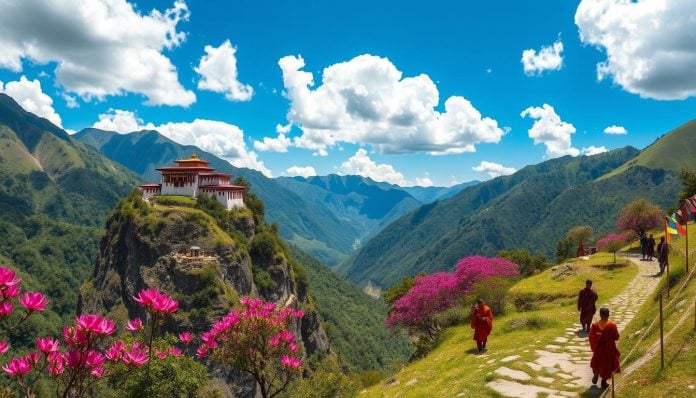Bhutan is a tiny nation, but it’s also a carbon-negative haven. It’s packed with rich culture and natural scenery. This travel guide highlights Bhutan’s best spots, from monasteries to forests. Let’s explore the beauty and culture of Bhutan together.
Start your Bhutan adventure in Paro. It’s famous for the Tiger’s Nest Monastery, high up at 1,200 meters. Next, visit Thimphu, where old meets new between elevations of 2,000 to 3,800 meters. A 3.5-hour drive takes you to the beautiful rivers and spiritual sites of Punakha.
Then, see the calm Gangtey Valley and spiritual Bumthang. Discover the untouched beauty of Haa Valley too. In Khoma, textile lovers can enjoy traditional weaving and natural dyes. From Paro, it’s easy to reach Trongsa’s hilltop, 230 kilometers away. You’ll love the view from Dochu La’s 108 stupas, with the Himalayas in the background.
For those seeking adventure, Laya offers unexplored trails. Jigme Dorji National Park is great for wildlife lovers. Bhutan charms everyone, from its natural parks to active markets and high mountains like Mount Chomolhari. This guide makes sure you see Bhutan’s best. Are you ready to see why Bhutan is a must-see destination?
Paro: Gateway to Bhutan
Paro is the first sight for travelers entering Bhutan, offering a spectacular landing amidst mountains. This town is not just an entryway; it’s filled with historical and cultural gems. These attractions play a key role in the Bhutanese journey.
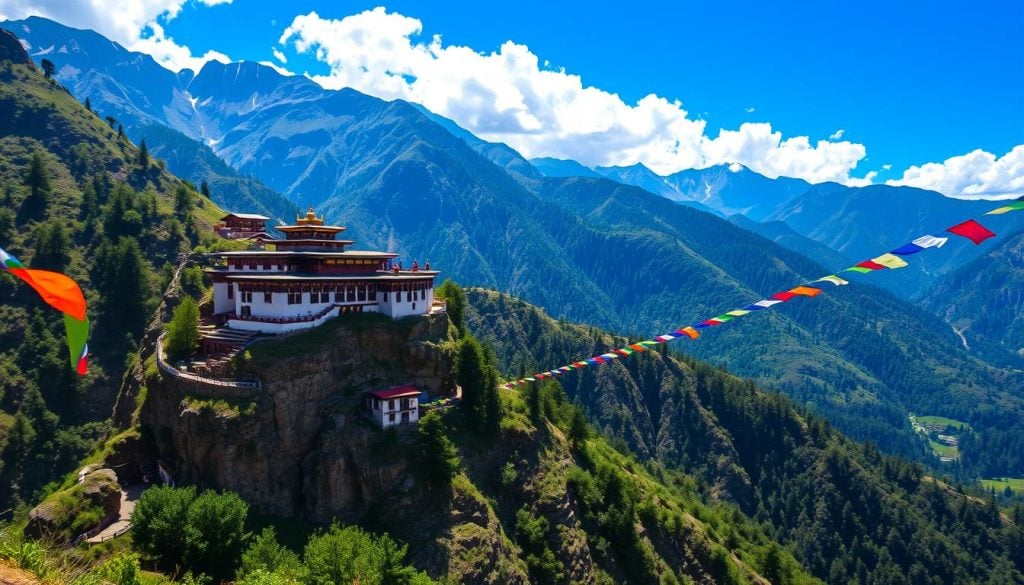
Highlights of Paro
In Paro, natural beauty and history merge perfectly. The National Museum, within an old watchtower, lets you explore Bhutan’s heritage. Rinpung Dzong, a fortress-monastery, is known for its stunning architecture and historical importance.
Must-Visit Sites in Paro
Paro hosts Bhutan’s finest sites. The legendary Tiger’s Nest Monastery is perched on a cliff, offering peace and stunning views. The Paro Weekend Market buzzes with activity, selling local crafts and food. Also, the Ugyen Pelri Palace showcases both beauty and history.
The Chele La Pass provides incredible views, best seen from April to June. Tamchoe Monastery, at 2,156m, appeals to spiritual seekers.
Travel Tips for Paro
To enjoy Bhutan’s highlights, make proper travel plans. It’s wise to hire a guide for exploring Paro’s cultural and historical spots. Try local momos and shop at markets; carry cash. For Tiger’s Nest, the entrance fee is Nu 500. Lastly, prepare for higher altitudes for a smooth experience.
Thimphu: Blend of Tradition and Modernity
Thimphu, Bhutan’s capital, mixes old traditions with modern life. As you walk around, you’ll see cultural sites, enjoy lively nights, and find unique things to do. This guide helps you explore life in Bhutan’s capital.
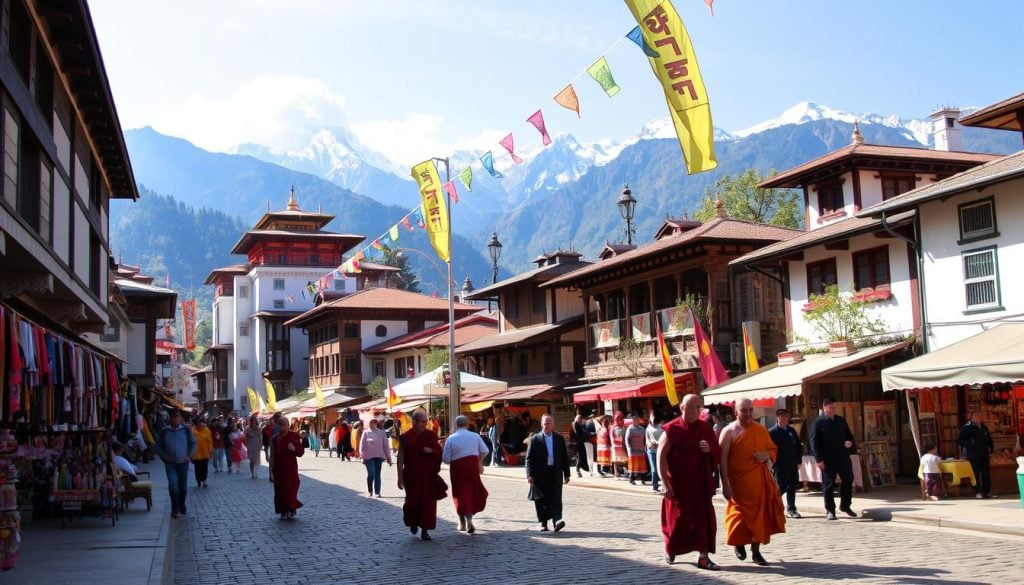
Cultural Landmarks in Thimphu
In Thimphu, you can visit many cultural spots. The National Memorial Chorten, built in 1974, is a key site where people walk around in a circle. It costs INR 300 to enter. The Folk Heritage Museum, in a traditional 19th-century house, charges INR 150 for entry.
- The Buddha Dordenma Statue is huge, over 51 meters tall, with 125,000 smaller Buddhas inside. It shows Bhutan’s deep Buddhist faith.
- Tashichho Dzong, from 1641 and home to Bhutan’s government since 1962, shows the country’s architecture and political history.
- The Bhutan Postal Museum lets you make your own stamps for 500 Ngultrum. It tells the story of Bhutan’s postal service through five galleries.
- Simtokha Dzong has over 300 slate carvings of Buddhist figures. It’s a haven for lovers of history and art.
- The Jungshi Handmade Paper Factory shows how traditional Bhutanese paper, deh-soh, is made.
Nightlife in Thimphu
Nightlife in Thimphu contrasts with its day life but is just as interesting. The city’s bars, clubs, and art venues are buzzing. Places like Mojo Park and the Grey Area are where people enjoy local drinks and live music. This mix of traditional and modern fun highlights Thimphu’s unique charm.
Unique Experiences in Thimphu
Thimphu isn’t just about sights; it’s also about local traditions. The Weekend Market runs Saturdays and Sundays from 7:00 AM to 8:00 PM. There, you can buy spices, meats, and vegetables. Watching or joining an archery tournament is another special activity. Competitors aim their arrows over 140 meters.
| Landmark/Activity | Location | Entry Fee |
|---|---|---|
| National Memorial Chorten | Thimphu | INR 300 |
| Folk Heritage Museum | Thimphu | INR 150 |
| Motithang Takin Preserve | Thimphu | 30 Nu |
| National Postal Museum | Thimphu | INR 150 |
| Weekend Market | Thimphu | Free |
From old landmarks to buzzing nightlife, Thimphu mixes history with the present beautifully. Whether you’re into exploring cultural spots or experiencing Thimphu’s modern side, you won’t forget your time here.
Punakha: A Spiritual and Scenic Haven
Punakha sits beautifully at 1,200 meters above sea level, showing off Bhutan’s stunning landscape and spirit. It’s tucked at where the Pho Chhu and Mo Chhu rivers meet, with plenty to see. The town mixes historical depth with outdoor fun for an unforgettable visit.
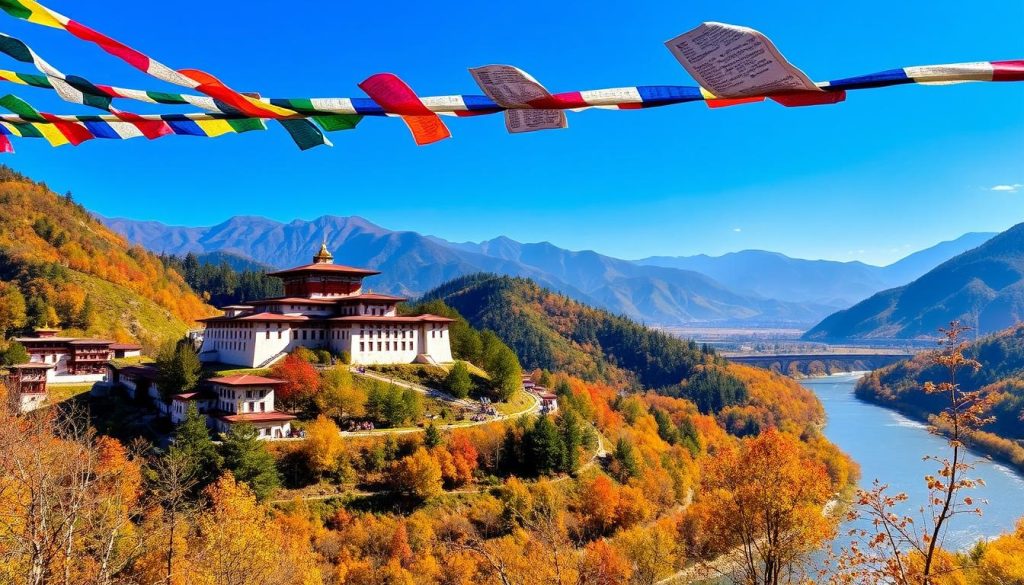
Main Attractions in Punakha
The Punakha Dzong is known as the Palace of Great Happiness, standing as the heartbeat of the town. With its breathtaking architecture and rich past, it’s a key highlight. Nearby, the Chimi Lhakhang temple offers spiritual blessings and intriguing tales.
For the adventure-seekers, white-water rafting on the Mo Chhu river is a thrill. Then, the Punakha Suspension Bridge, with its prayer flags, provides lovely views of the valley. These spots make Punakha a top pick in Bhutan.
Best Time to Visit
Choosing when to go to Punakha can make your trip even better. The months from March to May and September to November are perfect. The weather is great for outdoor adventures and seeing Punakha’s countryside.
Let this guide help you dive into the wonders of Punakha, a magical place in Bhutan.
Gangtey Valley: Nature’s Paradise
Gangtey Valley, nestled in the heart of Bhutan, is a haven for those seeking peace and adventure. It’s perfect for exploring Bhutan’s vacation spots with lush landscapes and rich culture.
Outdoor Activities in Gangtey Valley
The valley offers a range of outdoor adventures. The famous Gangtey Nature Trail is an easy 5.5 km hike that takes around 2 hours, showing off the valley’s scenic beauty. Thrill-seekers can enjoy archery, a loved traditional sport, and biking routes through stunning terrain.
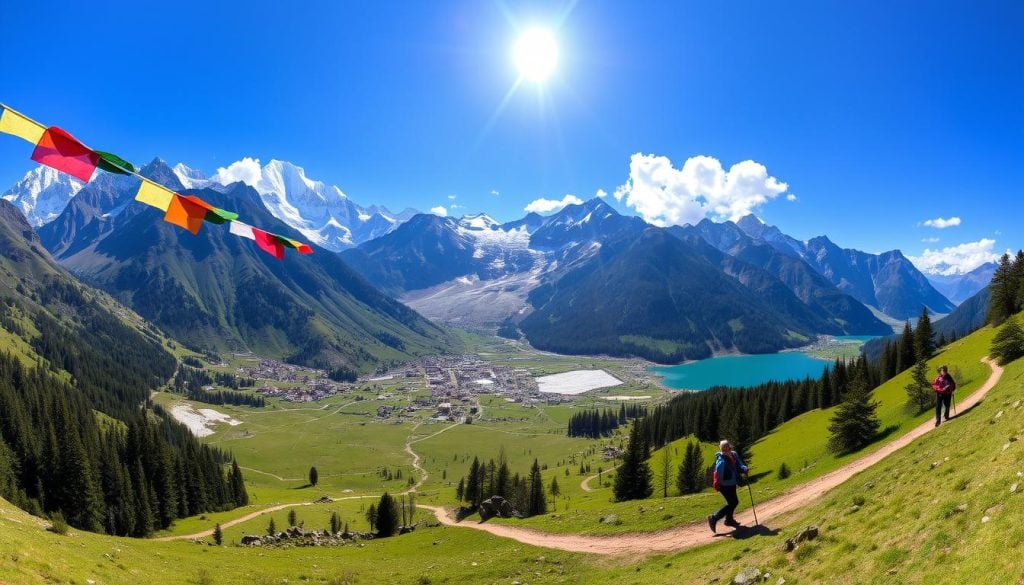
Birdwatching is big here, especially from late October to mid-March, to see the majestic black-necked cranes. At the Black-Necked Crane Information Centre, names range from Nu 15 for locals to Nu 120 for international tourists, offering deep insights into these endangered birds.
For an immersive experience, try open-air camping in the valley. This requires permission due to protected areas, offering a unique nature connection. Or, explore Tenkhor Yuetshe village for a taste of rural Bhutan life and hospitality.
Exploring Gangtey Goemba
Gangtey Goemba, a 17th-century monastery, is a must-visit in Gangtey Valley. Entry is free, providing stunning views of the farmlands. Khumbu Lhakhang monastery, open from 9:00 AM to 4:00 PM without any entry fee, adds to the experience.
Cultural festivals like Gangtey Tshechu showcase Bhutanese heritage with masked dances and traditional performances. Don’t miss the traditional stone bath (‘Dotsho’), using hot stones and herbs for rejuvenation.
Gangtey Valley is the essence of Bhutan; it offers hiking, birdwatching, and ancient treasures. It leaves you feeling wonderstruck and peaceful.
Bumthang: Heart of Bhutanese Spirituality
Bumthang is the ultimate spot for experiencing Bhutan’s spiritual side. It sits at the heart of Bhutan and is known for its sacred nature. The area comprises four untouched valleys filled with history, tradition, and a mystical vibe.
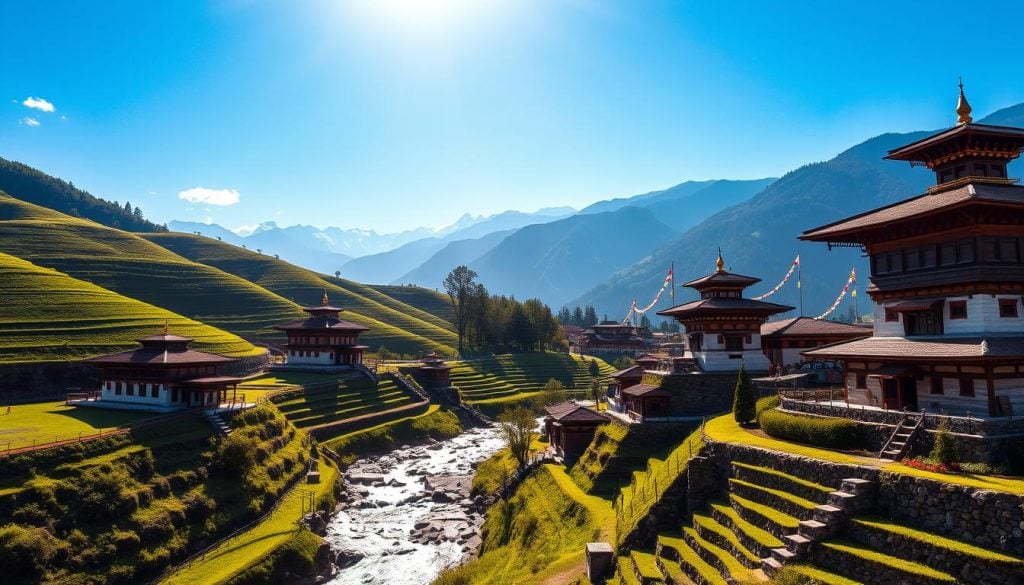
Historic Temples
Known for its ancient temples, Bumthang is a must-visit. Don’t miss Jampey Lhakhang, built in the 7th century, and Jakar Dzong, the “Fortress of the White Bird”. Kurje Lhakhang is also famous for preserving Guru Rinpoche’s body print. These places are more than religious sites; they are architectural gems that showcase Bhutanese culture.
Unique Local Foods
Tasting Bumthang’s local cuisine is part of the spiritual journey. Try the Bumthang Swiss Cheese from the Bumthang Cheese Factory. It offers a peek into Bhutanese dairy. Thukpa, a spicy noodle soup, combines flavors from Eastern Tibet. Also, don’t skip the Red Panda Beer Factory for a local brew experience.
Visitor Information
Bumthang’s winters are cold, and hotels often lack heating. Most tourists prefer visiting in warmer months, with the season ending in early December. For ease, consider flying domestically to Bumthang. The roads can be tough due to rough terrain.
The Pema Choling Shedra nunnery, founded in 2001, is Bhutan’s first Buddhist College for women. It offers unique insights into the culture and education.
| Feature | Details |
|---|---|
| Historic Sites | Jampey Lhakhang, Jakar Dzong, Kurje Lhakhang |
| Local Foods | Bumthang Swiss Cheese, Thukpa, Local Brews |
| Visitor Tips | Cold winters, Limited heating, Peak season until December |
| Special Sites | Pema Choling Shedra Nunnery |
Haa Valley: Untouched Natural Beauty
The untouched wilderness in Bhutan is a special hideaway in nature. Haa Valley shows off this calm beauty. It’s full of bright green valleys and forested areas, perfect for hikes and discovering new sights.
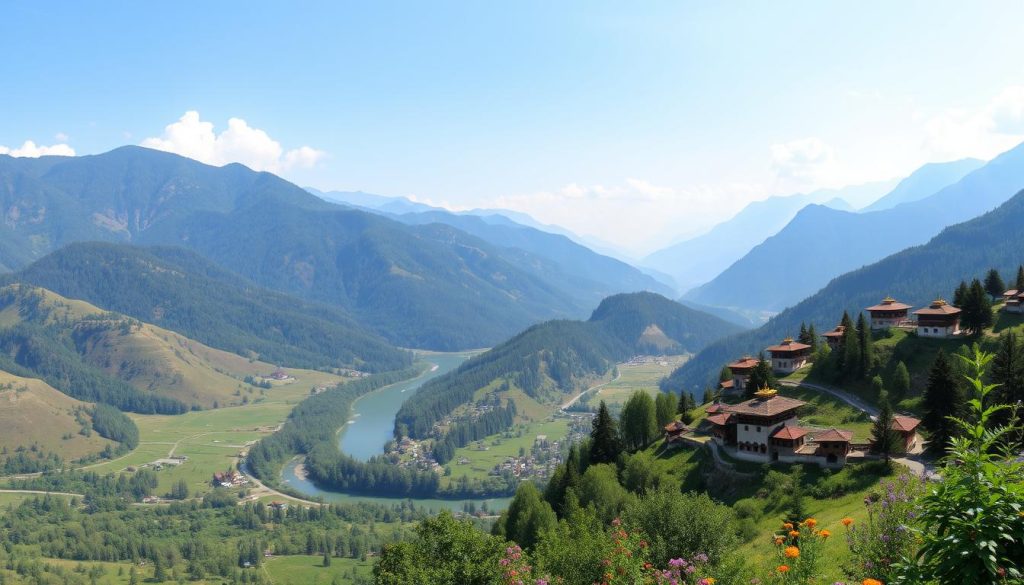
Two famous Haa Valley hikes are the Haa Panoramic Hiking Trail and the Sagala Trek. They take walkers through beautiful sceneries and sweet villages with monasteries. These trails show off the scenic beauty of Bhutan in a pure way, making every step a walk through time and nature.
For a peaceful end to the day, visitors can relax by the Haa River. Its calm waters and stunning views show the untouched charm of Bhutan. It’s the perfect place to chill after a day of walking and exploring.
| Top Attractions in Haa Valley | Highlights |
|---|---|
| Juneydrak Hermitage | An ancient meditation site offering panoramic views. |
| Katsho Goemba | A prominent monastery in the valley. |
| Lhakhang Karpo | Known as the “White Temple” with rich historical significance. |
| Lhakhang Nagpo | The “Black Temple,” contrasting yet complementing Lhakhang Karpo. |
| Rigsum Gonpo | Offers religious and cultural insights. |
| Trout Farm | A unique attraction focusing on fish farming. |
| Wangchuk Lo Dzong | A fortress with historical and strategic importance. |
| Yangthang Goemba | A secluded monastery perfect for introspection. |
Whether for spiritual peace or adventure, Haa Valley has something special. It invites you to explore the untouched wilderness in Bhutan, enjoy hiking, and take in the beauty. This place offers a deep connection with nature that lasts well beyond your visit.
Khoma: For Textile Enthusiasts
Khoma Village lies in Lhuentse District, Bhutan. It’s a must-visit for fans of traditional weaving and Bhutanese art. This village displays the detailed work that is key to Bhutan’s cultural heritage.
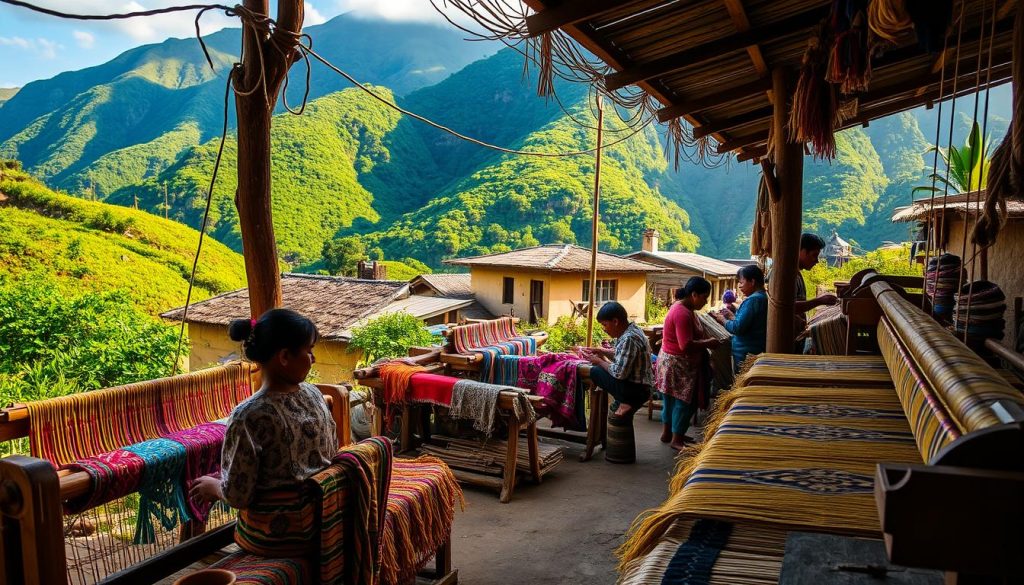
Traditional Weaving in Khoma
Khoma’s textiles are famous for their complex patterns and bright colors. In the village, each family owns a traditional back-strap loom. There, many weavers have perfected their craft. Visitors can watch these experts, learning about their commitment to Bhutanese craftsmanship.
Locally Made Dyes and Fabrics
The textiles from Khoma stand out because of both skillful weaving and local dyes. These natural dyes come from area plants and minerals, making the fabrics sustainable and genuine. Exploring this dye use unveils much about the cultural heritage of Bhutan.
“Khoma is a hidden gem for textile lovers. It allowed me to immerse myself in the rich traditions of Bhutanese weaving and gain a deeper appreciation for the artisans’ work.” – Visitor Review
- Experience traditional textile weaving workshops.
- Participate in hands-on weaving sessions.
- Learn about the natural dyeing process using local plants and minerals.
- Explore the village and its surrounding hills for a holistic cultural experience.
If you love textiles or want to dive into Bhutan’s artisan history, Khoma offers an educational and immersive experience. It’s a deep dive into Bhutanese craftsmanship at its core.
10 Best Places to Visit in Bhutan
Bhutan, known as the Land of the Thunder Dragon, is truly magical. It’s filled with amazing spots, from cities rich in culture to peaceful valleys. Exploring Bhutan, you can follow popular routes or discover hidden spots. Either way, it’s an unforgettable journey.
Essential Destinations
There are must-see places in Bhutan that everyone should visit. The Taktsang Monastery, or Tiger’s Nest, is amazing. It sits on a cliff near Paro. Thimphu, the capital, is also special. It’s the only capital without traffic lights, featuring sites like the King’s Memorial Chorten.
In Thimphu, you’ll also find the National Folk Heritage Museum. Another great place is Punakha. It’s known for its impressive 17th-century Punakha Dzong and the lively Punakha Tshechu festival.
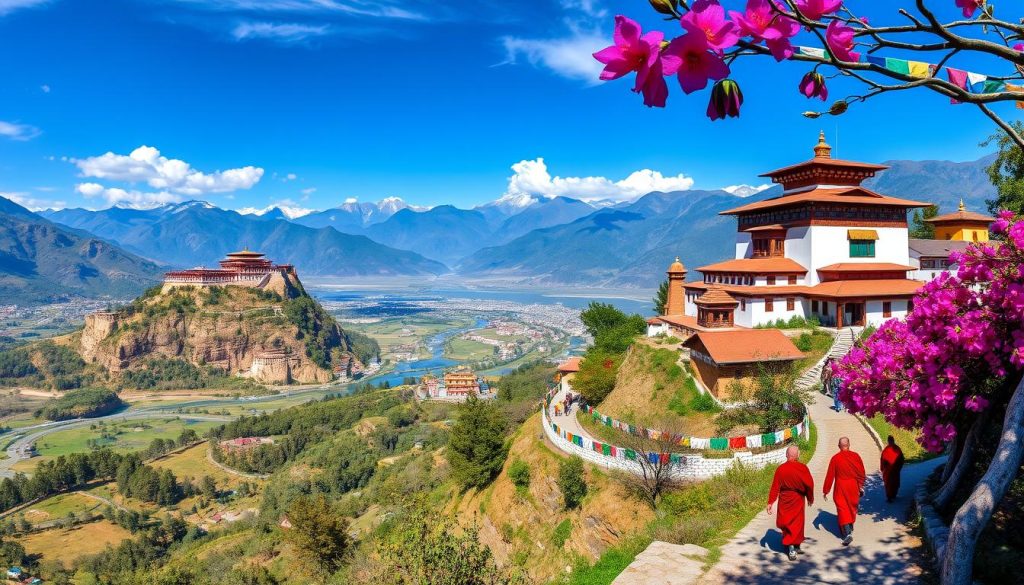
Another breathtaking site is the Dochula Pass, with its 108 stupas. They honor Bhutanese soldiers lost in 2003. The pass has stunning views of the Himalayas. Bumthang Valley, the spiritual center, is home to historic temples and the unique Red Panda brewery.
Hidden Gems
Bhutan is also full of lesser-known treasures. The Haa Valley offers ancient holy sites like the 7th-century Lhakhang Kharpo. In Trashigang, you can experience traditional festivals at the Trashigang Dzong, built in 1659.
Heading east, Mongar is known for its weaving and landscapes. Trongsa gives insights into Bhutan’s past with its commanding Trongsa Dzong. These places add depth to the Bhutanese adventure, offering unique cultural and historical experiences.
With these 10 destinations, you can mix famous sights with the hidden ones for a rich journey through Bhutan. This trip is filled with both well-known highlights and undiscovered spots, promising a memorable experience in this mystical kingdom.
Trongsa: Historical and Cultural Hub
Trongsa, located in central Bhutan, is known for its rich history and culture. It links the eastern and western parts of Bhutan. The famous Trongsa Dzong is a main highlight here.
Significance of Trongsa Dzong
Built in 1644, Trongsa Dzong stands as a key piece of Bhutan’s history. It was central in controlling trade and served as a vital center of authority in the 19th century. The dzong sits atop a steep ridge, offering breathtaking views.
The Trongsa Dzong celebrates the annual Trongsa Tshechu festival. This five-day festival honors Guru Rimpoche’s arrival in Bhutan during the 8th century. It’s a time for visitors to dive into local culture and history.
Trongsa’s watchtower now houses a museum dedicated to the Wangchuck dynasty. This museum gives insights into the family that shaped Bhutan today.
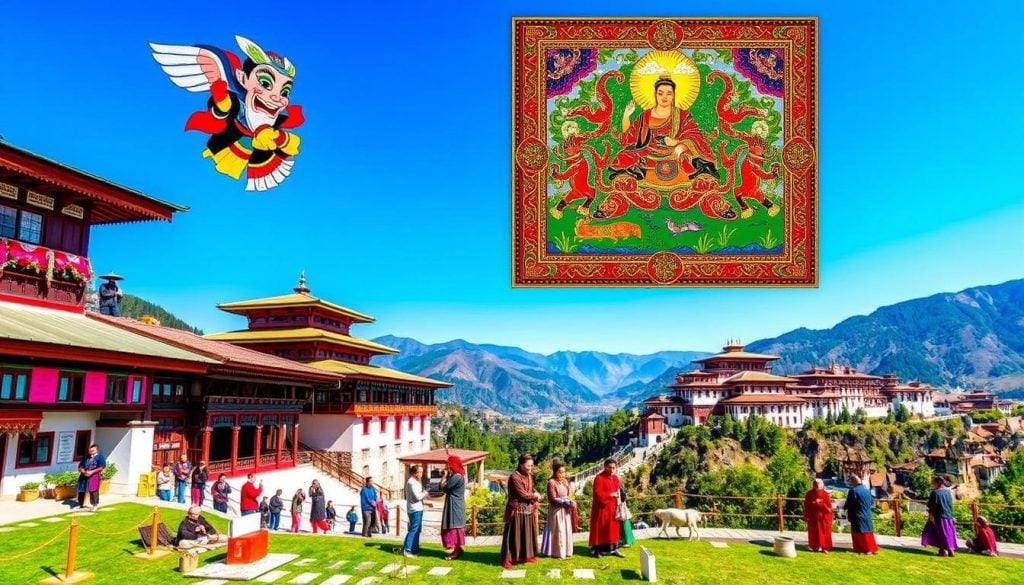
Exploring Local Markets
Trongsa’s historic dzong is surrounded by vibrant markets. These markets offer a variety of local crafts and goods. You’ll find everything from textiles to handmade artifacts here.
Shopping at these markets helps support local workers. It also offers a chance to take a piece of Bhutan home. These markets are both enlightening and unforgettable.
| Aspect | Details |
|---|---|
| Year of Construction | 1644 |
| Main Events | Trongsa Tshechu Festival |
| Strategic Importance | Controlled East-West Trade, Center of Authority |
| Main Attractions | Trongsa Dzong, Ta Dzong Watchtower, Local Markets |
Visiting Trongsa offers a deep look at Bhutan’s history and culture. It combines historical landmarks with vibrant cultural experiences, embodying the heart of Bhutan.
Dochu La: Scenic Rest Stop
Dochu La Pass stands tall at 3,100 meters, a jewel among Bhutan’s landscapes. It’s not only a feast for the eyes but also rich in history and spirituality. This makes it a top spot for anyone exploring Bhutan.
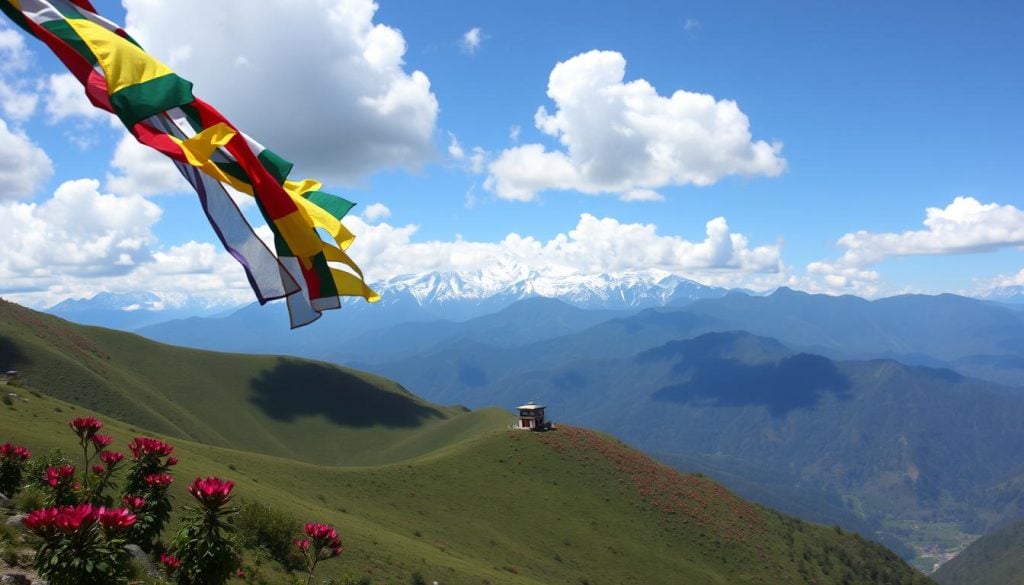
History of the 108 Stupas
The stunning sight of the 108 Druk Wangyal Chortens graces Dochu La. They honor Bhutanese soldiers who died fighting insurgents in 2003. The stupas are set in three layers, creating a serene ambiance. The first layer has forty-five, the second thirty-six, and the topmost twenty-seven.
The area also features the Druk Wangyal Lhakhang, finished in June 2008. It celebrates a century of Bhutanese monarchy. Moreover, the annual Dochula Druk Wangyel Tshechu festival, starting in 2011, brings global visitors every December 13. It highlights the landmark’s global appeal.
Panoramic Views of the Himalayas
Seeing the Himalayas from Dochu La Pass is unforgettable. On clear days, Gangkar Puensem shows its grandeur, standing as the world’s tallest unclimbed mountain at 7,158 meters. The area is also alive with colorful prayer flags, dancing in the wind.
Diverse flowers like Primula Denticulata and rhododendrons add to the charm, delighting nature lovers. This mix of natural and spiritual elements makes the pass truly special.
| Key Aspect | Details |
|---|---|
| Altitude | 3,100 meters |
| Memorial Chortens | 108, arranged in three layers |
| Major Festival | Dochula Druk Wangyel Tshechu |
| Best Viewing Period | October to February |
| Nearby Sight | Druk Wangyal Lhakhang |
Visiting Dochu La Pass lets you dive into the essence of Bhutan tourism. It’s where deep history meets breathtaking sights, creating a peaceful retreat.
Trashigang: Gateway to Eastern Bhutan
Trashigang is the largest district in Bhutan. It’s known as a key gateway for exploring Eastern Bhutan. It’s an important place for adventurers. They start here to explore the east, where the mysterious Yeti is said to live.
The Trashigang Dzong is a highlight in Trashigang. This fortress shows Bhutan’s architectural talent and history. Once a hub of power, it now anchors Trashigang Sightseeing.
The area is famous for its Traditional festivals. These festivals attract people worldwide. The Trashigang Tshechu, for instance, showcases mask dances and cultural acts. It helps visitors understand Bhutanese culture and religion.
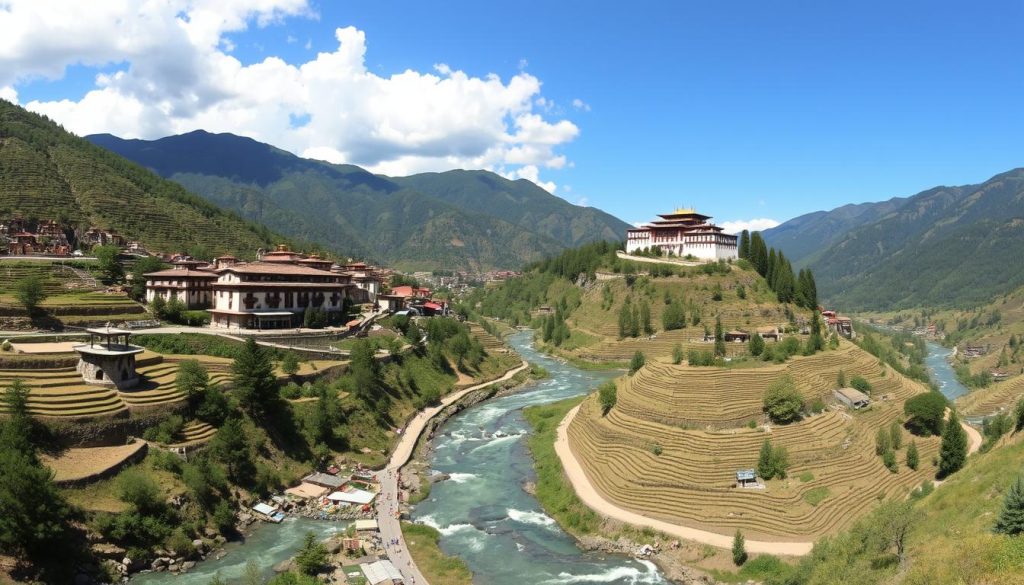
Trashigang is great for trekkers and travelers wanting to see eastern Bhutan’s untouched beauty. It’s perfect for exploring local customs, sights, or the Himalayas. This district has something for everyone.
| Destination | Suggested Stay Duration |
|---|---|
| Paro Taktsang (Tiger’s Nest) | 5-6 hours |
| Punakha Dzong | 1-2 hours |
| Thimphu | 3-4 hours |
| Trongsa Dzong | 2-3 hours |
| Gangtey Valley | 1 day |
Laya: Off-the-Beaten-Path Adventure
Laya sits in the far north of Bhutan, hidden and remote. It offers unique Bhutanese experiences you won’t find anywhere else. Being one of the most secluded places in the world, you can only reach it by a tough trek. This makes Laya a true adventure into uncharted Bhutan.
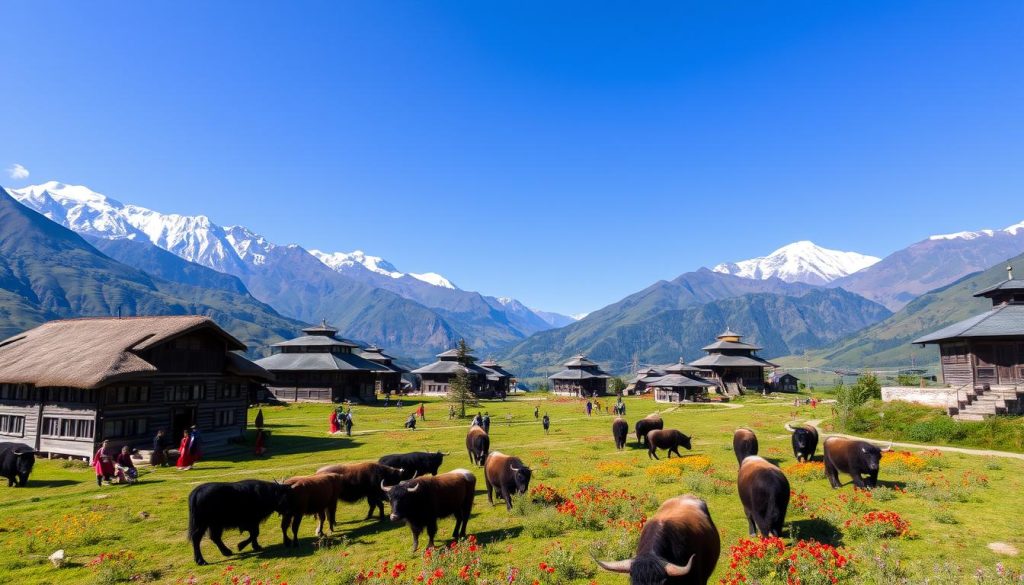
Indigenous Layap Culture
Exploring the Layap culture takes you deep into traditional Bhutanese life. The Layap people have a unique way of living. They raise yaks and farm cordyceps fungus. Their lifestyle provides a Laya cultural adventure you can’t get elsewhere. Here, you’ll see ancient practices that are still alive today.
Royal Highland Festival
The Royal Highland Festival is a big deal in Laya. This yearly event celebrates Layap culture, traditions, and sports. It’s crucial for seeing real Bhutanese life. The festival draws everyone in Laya together. It mixes celebration and tradition in a part of Bhutan few get to see.
Visiting Laya and the Royal Highland Festival lets you see their culture up close. It’s key to feeling the unique Bhutanese experiences in a little-known part of Bhutan.
Phobjikha Valley: Home of the Black-Necked Cranes
Phobjikha Valley sits 3,000 meters high in Central Bhutan. It’s a beautiful glacial valley perfect for wildlife lovers. Next to Jigme Singye Wangchuck National Park, it’s full of animals like red foxes, leopards, and wild boars. Plus, it’s a crucial spot for black-necked cranes.
Wildlife Viewing
This valley is the winter spot for the rare black-necked crane. These unique birds arrive in mid-November and stay until early March. Along with cranes, you can see other animals showcasing Bhutan’s wildlife. Try walking the trails, and you might spot red foxes or leopards.
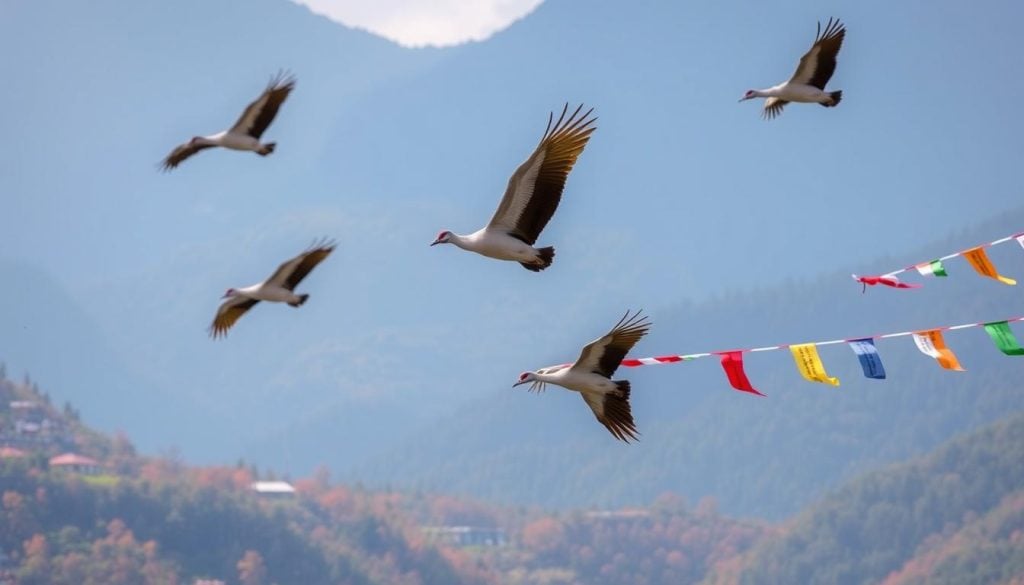
Cultural Festivals
But there’s more than wildlife here. Phobjikha Valley also highlights Bhutan’s festivals. The Crane Festival at Gangteng Monastery is a key event each November. It celebrates the bond between nature and Bhutanese culture through music, dance, and performances. The monastery, dating back to the 1610s, is a major cultural site for the Nyingmapa School of Buddhism.
The valley is alive with agriculture, growing turnips and potatoes. Two rivers, Nakay Chhu and Gay Chhu, flow through, enhancing its beauty. For a local meal, visit the Dewachen Hotel. Enjoy dishes like Ema Datshi, Red Rice, and the beloved Butter Tea.
Here’s a glimpse of what Phobjikha Valley offers:
| Attractions | Details |
|---|---|
| Black-necked Cranes | World’s only alpine cranes, observed November to March |
| Gangteng Monastery | Built in the 1610s, Nyingmapa School of Buddhism |
| Jigme Singye Wangchuck National Park | Home to red foxes, leopards, wild boars |
| Crane Festival | Traditional festivities celebrating the black-necked cranes |
| Traditional Cuisine | Dewachen Hotel serving Ema Datshi, Red Rice, Dal, Hogi Salad, Suja |
Phobjikha Valley is a gem for anyone interested in nature and culture. It’s a top spot for wildlife adventures and getting into Bhutan’s natural and cultural spirit.
Jigme Dorji National Park: A Wildlife Paradise
Exploring Bhutan’s wildlife leads you to the extraordinary Jigme Dorji National Park. It’s Bhutan’s second-largest national park, covering 4316 square kilometers. It includes the districts of Gasa, Thimphu, Paro, Punakha, and Wangdue Phodrang. This park is a testament to Bhutan’s commitment to preserving nature and biodiversity.
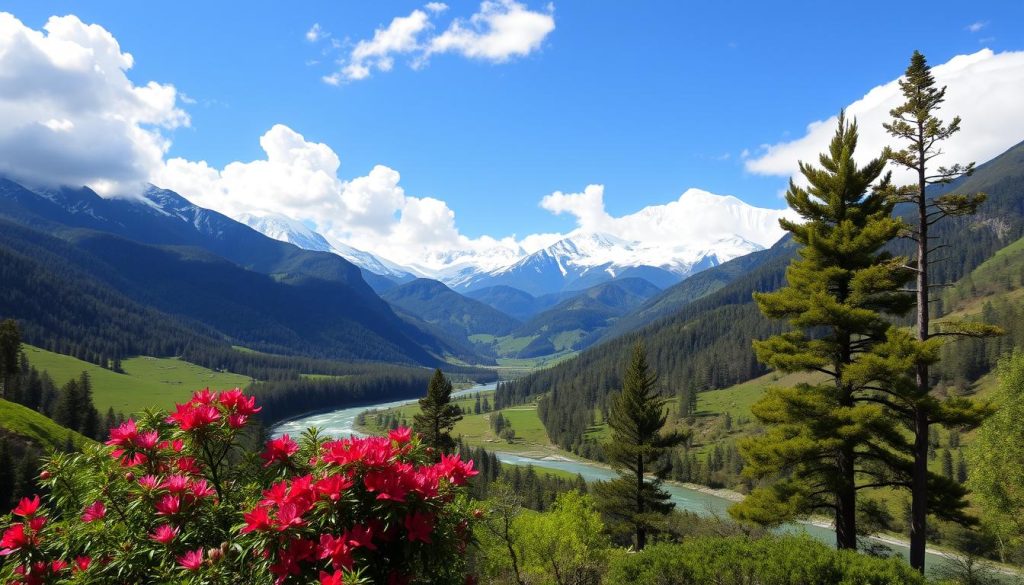
The park is home to a wide array of wildlife. You’ll find more than 300 bird species, 36 mammals, 300 medicinal plants, 39 butterflies, and 5 reptiles. Its unique feature is the coexistence of snow leopards and Bengal tigers above 4000 meters. This makes it a captivating place for those who love untouched nature.
The park is also known for its diverse landscapes. It extends across different climates, from freezing ice fields to rich broadleaf forests. Highlights include glaciers, alpine areas, hot springs, waterfalls, and healing baths. These features make it a favorite spot for nature lovers.
Cultural harmony is equally prominent here. Over 6500 Layap people live within the park. They engage in farming and animal husbandry. The blend of plant life, animals, and local culture makes visiting Jigme Dorji National Park a complete experience, not just a trip.
Here is a detailed comparison of some of Bhutan national parks:
| National Park | Size (km2) | Unique Features |
|---|---|---|
| Jigme Dorji National Park | 4316 | Home to snow leopards and Bengal tigers; vast biodiversity; multiple climatic zones |
| Royal Manas National Park | 1057 | Known for its grasslands and lowland tropical forests |
| Jigme Singye Wangchuck National Park | 1730 | Wide variety of habitats, from broadleaf forests to alpine meadows |
| Phibsoo Wildlife Sanctuary | 278 | Incredible biodiversity with significant species of trees and wildlife |
The ideal time to visit Jigme Dorji National Park is from March to October. The best chance to see snow leopards is in September. The park is open Monday through Friday, 9 AM to 5 PM. There’s an entry fee of 150 INR. Discovering Bhutan’s untouched nature at Jigme Dorji National Park is a truly enriching adventure.
Conclusion
Exploring Bhutan gives you a mix of culture, spirituality, and amazing scenery. Bhutan only has about 800,000 people. They follow a ‘High Value, Low Volume’ tourism approach. This makes every visit very special. You can see the amazing Tiger’s Nest Monastery, built in the 17th century and rebuilt in 2005. There’s also the peaceful Gangtey Valley. Both offer unforgettable cultural moments.
Bhutan’s tourism shows off its history and lively traditions. Go to the local markets of Wangdue Phodrang or find peace at Tamshing Goemba monastery, established in 1501. See the grand Punakha Dzong, located where two rivers meet. This place shows the genius of Bhutanese architecture. Also, Kurjey Lhakhang holds the remains of the last three kings. There, you can see a sacred meditation cave for a deep spiritual moment.
If you love adventure, drive to Chele La, the highest pass you can reach by car at 3,988 meters. Don’t miss the view from Dochula Pass with its 108 stupas. See the giant Buddha Dordenma Statue in Thimphu, among the biggest in the world. It symbolizes Bhutan’s dedication to keep its cultural and spiritual identity alive. Traveling through Bhutan, you’ll find deep cultural touches. These show their commitment to sustainable tourism. Thus, Bhutan’s enchanting beauty, spirituality, and culture are preserved for generations to come.

































